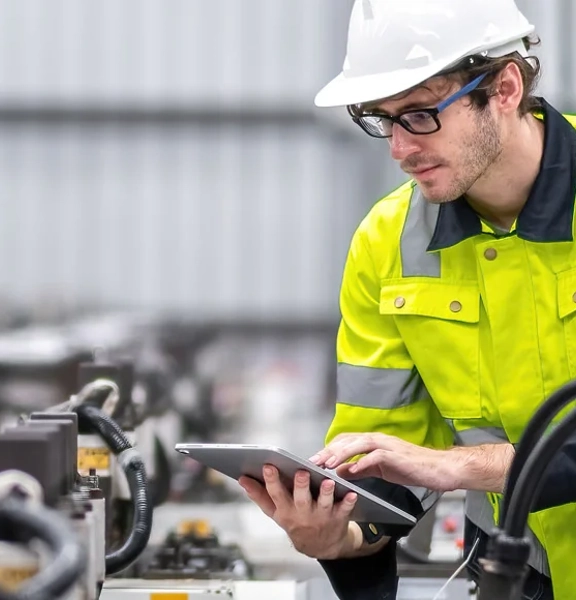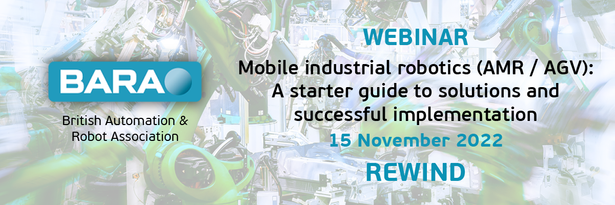Become a member
Take advantage of exclusive member benefits, world class events, networking and specialist support








 Become a member
Become a member 

The British Automation & Robot Association (BARA) hosted their webinar centred around Mobile Industrial Robotics, a starter guide to solutions and successful implementation. A panel of industry specialists discussed mobile robotics, in particular AMR (Autonomous Mobile Robots) and AGV’s (Autonomous Guided Vehicles).

Key Topics Discussed:

Machinery Update is the official publication of the PPMA (Processing and Packaging Machinery Association). Launched in 1989, Machinery Update has developed an unrivalled reputation as the prime source of information amongst buyers and specifiers for the processing and packaging industry as a whole.

Ross Lacy started working for RARUK Automation six years ago, initially joining the team as a dedicated Universal Robots Sales Engineer in 2016. However, over time Ross’s interest in MiR’S autonomous mobile robots grew and in 2018 he became the MiR Product Manager for RARUK. In partnership with MiR, RARUK Automation were able to offer cost-effective and easy internal transport and logistics solutions, which proved highly popular across many sectors. RARUK sold more MiR robots than any other distributor across the world in 2019. With continued sales success, the team at RARUK expanded to include MiR technical support staff. Over the years, Ross has been involved in RARUK continuing to develop their relationship with MiR, third party suppliers like ROEQ and integration partners to offer the best possible customer experience.

Paul has over 25 years’ technical sales experience in VNA forklift trucks, material flow analysis & mobile automation. A software engineering graduate, he also has experience in designing and delivering server, desktop and embedded PLC applications for automated and semi-automatic (driver assistance) vehicles. Taking his skills and experience and mixing them with a straight-talking manner, Paul is often found in the role of Trusted Advisor, ensuring that customer solutions are realistic, deliverable, honest and grounded in realistic data.

Matthew Rollins, ABB AMR specialist aims to promote the adoption of AMRs and robotics into suitable environments with a focus an passion for new technology. Having previously enjoyed several roles across various industries within automation and robotics over the past 17 years, he draws from his extensive range of knowledge and involvement in the introduction of innovative technology to deliver return on investment. Matthew’s success comes from helping develop robotic solutions within emerging industries, helping support businesses with their first steps into automation. ABB is a leading robotic manufacturer and solutions provider.

George is currently a Team Leader at OMRON for Application Engineers specialised in Robotics, Safety and Vision. During his time at OMRON, he has served various roles but dedicated a majority of his time as a robotics Application Engineer, supporting customers to visualise and implement their robotic projects involving traditional fixed, collaborative and Mobile robotic technologies. Working in this environment has helped him to realise the key benefits of robotics in industry and how the factory of the future can look with the correct technology.

Andy Macfadyen, Head of Robot Strategy has worked at iconsys for over 5 years, and previously at ABB Robotics. Starting from the ground up, Andy began his career as a maintenance engineer, progressing to robotics project engineer and now leads the charge with our industrial, collaborative, AGV and Autonomous Mobile Robotics (AMR) strategy. Andy brings a wealth of experience integrating numerous industrial robotic cells and AMR solutions into a number of key industries, including Metals, Pulp & Paper, Construction Materials, Logistics & Warehousing, Consumer Goods, Food & Beverage and Automotive. Andy has been instrumental in the development and integration of iconsys’ robot fleet management software platform AMRConnect™, which has been rolled out integrated into a number of our customers facilities. He also brings his expertise to our simulation and digital twin offering, ensuring customers can visualise and analyse automation solutions risk free prior to implementation.

It’s most likely going to be a mixed picture. Almost all the “easier” and “simpler” applications and processes will likely have been automated and in more cases than present there will be fully “lights-out” automated facilities. The remainder will be those without the funding, clear ROI or where human labour/control is simply better-suited.

Either would be suitable – the timing depends on the route. The biggest factor is disruption whilst on route. An AGV will simply stop if an obstacle is encountered – but also as the route is the same each time it’s probably (should be!) marked out and housekeeping at a level where an obstruction is not likely. An AMR will try and navigate around the obstruction, so it may get to the destination on time, or it might be late since it’s taken a longer route rather than wait for the obstacle to be removed. If the route is variable then it’s hard to mark this route to be kept clear (though again general housekeeping rules should be present to minimise this issue).

This depends on your application and what you call an AGV/AMR. There are AS/RS stacker crane systems that will lift well over 20 metres. If you’re considering free-roaming counterbalanced FLT AGV/AMR then it’s more reasonable to consider 8-12 metres.

Finance can be a barrier. Long-term change might be required to alleviate this. In the immediate term, a more flexible AMR solution could be beneficial as this could be re-configured if/when a contract is changed and the nature of the processes/transport movements change.

There is scope on both sides. In the UK we’ve got a particular problem with space in our collective factory estate, with many being designed around human operators and there being simply not enough space to operate AMR/AGVs with any kind of reliability (let-alone safety). AI is coming along with leaps and bounds but is still a way off in terms of operational reliability and the ability for a supplier/integrator to guarantee safety and behaviour given a set of determined inputs. The more abstract a decision system is (which is the point of an AI in once sense) the more difficult it is to predict what will happen, particularly in edge cases or uncommon occurrences. This is anathema to safety in industrial automation.

The first step is a Wi-Fi survey. This should be done as early in the process as possible once the initial high-level feasibility (i.e. can we handle the material flow demand in the space available, in the proposed environment) is completed. A Wi-Fi survey should be completed professionally.

This depends on the amount of the existing traffic that will be taken over by the automated system. If there is significant traffic remaining, then a traffic management plan/procedure will need to be in place to prevent disruption. This plan might be something as simple as a standing order/rule for manual traffic to give-way to automated or more concrete traffic control with traffic lights controlled by the AMR/AGV Traffic Manager.

Security for an AMR/AGV is about as robust as it is for any other type of industrial machinery. Hardware such as PLCs or Industrial PCs running equipment will be password protected. It’s not common for network traffic to be encrypted. Standard practice would be for the network the system (so Traffic Manager server, AGV/AMR) is running over to be a separate VLAN with very strict rules over communication outside of this. Remote support would be via a VPN or similar technology.

Software and Hardware development at the vehicle level is actually quite tightly coupled. It needs to be to enable us to get the operational reliability and confidence in the level of safety. Software development needs to be architected in such a way as to expect a certain hardware configuration and to stop the vehicle if the actual detected configuration doesn’t match that which was expected.

Engagement with the workforce. People don’t as a rule intentionally walk out in front of a manually driven vehicle, yet we do see intentional “testing” of an AMR/AGV safety and detection system. It’s this behaviour that needs to be addressed. There’s a line of thought coming out of the automotive side that actually this is a generational issue – there will be less distrust of the newer technology with each subsequent younger generation. Think of this as the difference in use of online banking (or even an ATM/cash machine) between the 50-60+ demographic and people aged 40 and below.

Yes – again subject to the type of application. There will still be for the foreseeable future processes and actions that a human operator is better suited to complete. Whether that human is physically on board the machine or they are teleoperating it from another office is another question. Automation costs will also rise since we have to pay the commissioning engineers, production personnel and so on.

Safety, control & operational reliability. The most critical industrial automation is subject to the expectation that it needs to run without incident 24/7, 365 days a year with exceptions being planned downtime for maintenance and/or upgrades. As we’ve seen recently, we have a fragile supply chain and any disruption can have massive effects. AI can be difficult to reliably integrate into an industrial process especially when we also have to document and guarantee the safety concept. This is most likely why AI is popular in an industrial setting for data collection & analysis/insights (especially useful for maintenance & downtime prediction) but the use in more critical areas will be much more cautious.

AGV’s and AMR’s require a different type of support. MHE training is to ensure that you use the equipment in a safe manor to avoid injury, the majority of the time mobile vehicles will be self-sufficient and run autonomously. People responsible for the autonomous vehicles will be responsible for ensuring the environment is consistent as possible i.e removing obstructions from the planned route to keep efficacy high. When breakdowns do occur, they will usually be minor and take minimal skill to rectify.

In some cases, both can be as easy as one another. Greenfield sites allow you to take a more methodical approach to the route planning which can lead to a more efficient system, but the success of a mobile robot system in my experience is down to good housekeeping.

An AMR/AGV won’t be faster than a flt driver, but a mobile robot doesn’t take breaks and allows you to run 24/7 production so technicly 1 AMR could replace 3 operators over a 3 shift period (Although considerations would need to be made for charging, redundancy etc.)

This is something that we have done before. It will always be easier to use robots from the same manufacturer as this will require minimal integration, although once the interface between the different manufacturers is defined you can generally scale with ease.

There are manafactuers that offer AGV’s for outdoor environments, although talking to some of them I believe they are for warmer climates than the UK. I think the limiting factor is the safety system.

Talk to the right person, that is independent of manufacturers! The correct integrator or consultant who can use robots from a number of manufactures will give you unbiased advice.
But it’s really about understanding your requirements in detail to understand the benefits between AGV’s/AMR’s or even a historic conveyor system.

We generally see that people upskill operators that have had their tasks replaced by mobile robots running these systems. They are usually very easy to run with minimal maintenance.